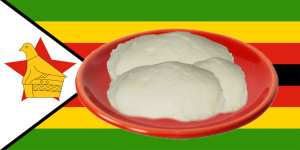Sadza from Zimbabwe
Sadza is the shona word to describe a thickened porridge prepared from any grain and therefore similar to the Ugali of Eastern Africa and Fufu of West Africa. The most commonly used ingredient for sadza is white maize meal, but if not available you can also use any other farina or corn meal. However most Ethnic food stores (African, Asian or Caribbean) will sell white maize Mealie-Meal. Sadza is a stapplefood in Zimbabwe and can be accompanied with both meat stews or just vegetables. The Shona people of Zimbabwe traditionaly do not eat meat daily and therefore the accompanying of Sadza with a meat stew is considered a real treat. Tradtional families might just serve sadza with one of the local vegetables. If you happen to visit a zimbabwean family and you will get served a delicious meal including meat you should consider yourself luckely since this is a sign of respect and importance of the guest. Because of the wide use of Sadza in most zimbabwean dishes, the word is even used to describe the meal itself and in combination with other Shona words it can mean either Lunch or dinner. The best way to enjoy Sadza is visiting a traditional zimbabwean family. However it’s also nice to try to cook this African dish yourself. Traditionally, sadza is cooked in a clay or cast iron pot on an open fire, but its also easy to make in your own house on a normal stove. Follow the easy instructions in this recipe carefully to make this delicious zimbabwean staple food and check out other recipes for zimbabwean stews to serve with Sadza.
both meat stews or just vegetables. The Shona people of Zimbabwe traditionaly do not eat meat daily and therefore the accompanying of Sadza with a meat stew is considered a real treat. Tradtional families might just serve sadza with one of the local vegetables. If you happen to visit a zimbabwean family and you will get served a delicious meal including meat you should consider yourself luckely since this is a sign of respect and importance of the guest. Because of the wide use of Sadza in most zimbabwean dishes, the word is even used to describe the meal itself and in combination with other Shona words it can mean either Lunch or dinner. The best way to enjoy Sadza is visiting a traditional zimbabwean family. However it’s also nice to try to cook this African dish yourself. Traditionally, sadza is cooked in a clay or cast iron pot on an open fire, but its also easy to make in your own house on a normal stove. Follow the easy instructions in this recipe carefully to make this delicious zimbabwean staple food and check out other recipes for zimbabwean stews to serve with Sadza.
Ingredients for Sadza
The only neccesairy ingredient for Sadza is white maize meal (if not available any other farina or corn meal will do)
How to make Sadza
This recipe is for Sadza as a side dish for about five people. If you have less or more eaters adjust the quantities below to your own calculations, however you can never have more then enough Sadza.
- First Step: Boil 1 gallon (4 liters) of water.
- Second step: put five cups of white maize meal in a sauce pan and add cold water to soak the meal.
- Third step: After the white maize meal is completely soaked one should add a little more water to stir the mixture with a thick stick (or a big wooden spoon).
- Fourth step: Put the fire of the sauce pan on medium heat and while stirring the mixture add the boiling water slowely and keep stirring in a constant way. Make sure the mixture doesn’t stick to the pan.
- fifth step: during the heating the maize meal will become smoother and becomes like a smooth porridge. let it boil while constantly stiring the mixture
- sixth step: Now let it boil for 5 minutes and add more maize meal flower.
How to eat the Sadza
Sadza is finger food. However the first time around you may wish to use a spoon until you have had a chance to observe an experienced person eat with their hands – it is quite and art! Wash your hand well in a bowl of clean water. Using your right hand (Shona: rudyi -lit. ‘the one used to eat’) partition a small chunk of sadza and mold it into a little round or oval ball of sadza called “musuwa we sadza” in your palm. Be careful not to burn yourself. Dip (Sh: tonha) it in the soup (Sh: muto) and bite off and eat a sizable chunk. Re-mold the remainder of your sadza in your palm and continue the process. Use your fingers to pick up and eat chunks of chicken or beef. Enjoy!
Sadza is normally shared by several people all eating from the same plate and bowl sitting in a circle on the floor. This environment provides amble opportunity to learn sharing as one has to pace themselves accordingly while eating with others. It is particularly interesting to watch children of different ages eat from the same servings. The older children, who may be capable of eating very quickly and consume most of food at the expense of younger slower kids. They will either pace themselves at the rate of younger children or consume a fair portion but leave enough food for the younger children to finish at their own pace – a tremendous way to instill sharing and responsibility.
